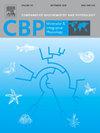The effects of individual differences in anxiety on anti-predator responses, thermal and hypoxia tolerance in zebrafish (Danio rerio)
IF 2.2
3区 生物学
Q4 BIOCHEMISTRY & MOLECULAR BIOLOGY
Comparative Biochemistry and Physiology A-Molecular & Integrative Physiology
Pub Date : 2025-06-25
DOI:10.1016/j.cbpa.2025.111899
引用次数: 0
Abstract
Anxiety, as a crucial stress response to potential threats in animals, exhibits significant individual differences, with high-anxiety individuals typically allocating greater attentional resources to threat detection. We hypothesized that such individuals would demonstrate enhanced threat sensitivity and anti-predator responses, but compromised stress tolerance due to constrained energy allocation. Using the novel tank diving test, we screened zebrafish (Danio rerio) with high- and low-anxiety phenotypes and compared their anti-predator responses (anxiety-like behaviors, metabolic rates, and predator avoidance behaviors) under predator chemical or visual cues, along with their thermal and hypoxia tolerance capacities under baseline conditions. The results demonstrate that high-anxiety zebrafish exhibit enhanced anti-predator responses in threatening environments, while showing no compromised stress tolerance at baseline. These findings demonstrate the adaptive superiority of the high-anxiety phenotype in high-predation-risk environments, providing theoretical foundations for understanding the evolutionary role of anxiety in fish.

焦虑的个体差异对斑马鱼抗捕食者反应、热耐受和缺氧耐受的影响。
焦虑作为动物对潜在威胁的重要应激反应,表现出显著的个体差异,高焦虑个体通常将更多的注意力资源分配给威胁检测。我们假设这些个体会表现出增强的威胁敏感性和反捕食者反应,但由于能量分配受限而降低了应激耐受性。利用新型的水箱潜水试验,我们筛选了具有高焦虑表型和低焦虑表型的斑马鱼(Danio rerio),并比较了它们在捕食者化学或视觉提示下的抗捕食者反应(焦虑样行为、代谢率和捕食者回避行为),以及它们在基线条件下的耐热和耐缺氧能力。结果表明,高焦虑斑马鱼在威胁环境中表现出增强的反捕食者反应,同时在基线上没有表现出损害的应激耐受性。这些发现证明了高焦虑表型在高捕食风险环境中的适应性优势,为理解焦虑在鱼类进化中的作用提供了理论基础。
本文章由计算机程序翻译,如有差异,请以英文原文为准。
求助全文
约1分钟内获得全文
求助全文
来源期刊
CiteScore
5.00
自引率
4.30%
发文量
155
审稿时长
3 months
期刊介绍:
Part A: Molecular & Integrative Physiology of Comparative Biochemistry and Physiology. This journal covers molecular, cellular, integrative, and ecological physiology. Topics include bioenergetics, circulation, development, excretion, ion regulation, endocrinology, neurobiology, nutrition, respiration, and thermal biology. Study on regulatory mechanisms at any level of organization such as signal transduction and cellular interaction and control of behavior are also published.

 求助内容:
求助内容: 应助结果提醒方式:
应助结果提醒方式:


